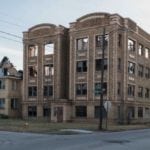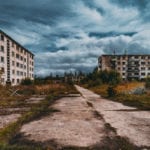 Humans
Humans  Humans
Humans  Animals
Animals 10 Ways Animals Use Deception to Survive
 Movies and TV
Movies and TV 10 Misdirections Directors Used to Manipulate Actors
 Politics
Politics The 10 Boldest Coup Attempts of the 21st Century
 Weird Stuff
Weird Stuff 10 Things That Would Have Killed You in the Old West
 Books
Books 10 Pen Names More Famous Than Their Authors
 Creepy
Creepy 10 Unnerving Legends from Around the World
 Movies and TV
Movies and TV 10 Amazing Lead Actor Ideas for Superhero Movies
 Our World
Our World 10 Crazy Facts about Cycads That Might Surprise You
 Technology
Technology 10 World-Changing Examples of Turning Dumb Technology into Smart Technology
 Humans
Humans 10 Inventors Who Died Awful Deaths in Their Own Creations
 Animals
Animals 10 Ways Animals Use Deception to Survive
 Movies and TV
Movies and TV 10 Misdirections Directors Used to Manipulate Actors
Who's Behind Listverse?

Jamie Frater
Head Editor
Jamie founded Listverse due to an insatiable desire to share fascinating, obscure, and bizarre facts. He has been a guest speaker on numerous national radio and television stations and is a five time published author.
More About Us Politics
Politics The 10 Boldest Coup Attempts of the 21st Century
 Weird Stuff
Weird Stuff 10 Things That Would Have Killed You in the Old West
 Books
Books 10 Pen Names More Famous Than Their Authors
 Creepy
Creepy 10 Unnerving Legends from Around the World
 Movies and TV
Movies and TV 10 Amazing Lead Actor Ideas for Superhero Movies
 Our World
Our World 10 Crazy Facts about Cycads That Might Surprise You
 Technology
Technology 10 World-Changing Examples of Turning Dumb Technology into Smart Technology
Top 10 Toxic Ghost Towns
Many deserted towns around the world are dangerous to visitors. Several of these places were abandoned after severe environmental damage had occurred, and the residents became extremely ill. Much of the damage and toxic aftermath lingers for years, and these ghost towns can still harm tourists today.
10Picher, Oklahoma
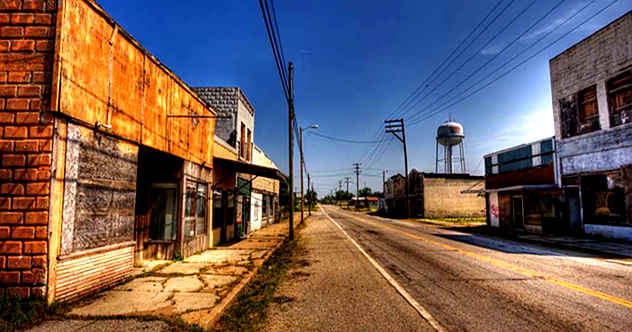
Picher sprang up after lead and zinc deposits were discovered in 1914. The population quickly grew as both metals were needed during World War I. Picher’s miners helped fill the demand: more than half of the lead and zinc used during the war came from local mines. Eventually, the town became one of the largest exporters of lead and zinc in the world.
Unfortunately, mining left behind a toxic byproduct called chat—a poisonous, chalky, white grit. After the mining stopped in the 1970s, there was an estimated 178 million tons of chat, mill sand, and sludge piled around the town.
The townspeople had no idea that chat was highly poisonous. They used it to fill their driveways and their children’s sandboxes.[1] Families picnicked on the chat mounds, children rode their bikes on them, and the high school track team trained on them.
In the 1990s, a school counselor learned of a link between lead and learning disabilities. Children were tested, and 46 percent of the students had unsafe levels of lead in their blood. The government attempted to clean up the town, but they gave up when sinkholes started to appear. Most of the town’s buildings were in danger of collapsing. The government knew that they needed to get people out of Picher, so they approved a buyout to relocate the town’s residents. Nearly everyone left, although a few people chose to stay.
The town is still toxic. While the air quality meets the government’s minimum standards, windy days blow large amounts of lead throughout the city. Even wildlife is not safe from the area’s toxins. In 2015, more than 1,000 migratory birds were found dead across Picher. It is believed that they died of zinc poisoning.
9Bikini Atoll, Republic of the Marshall Islands
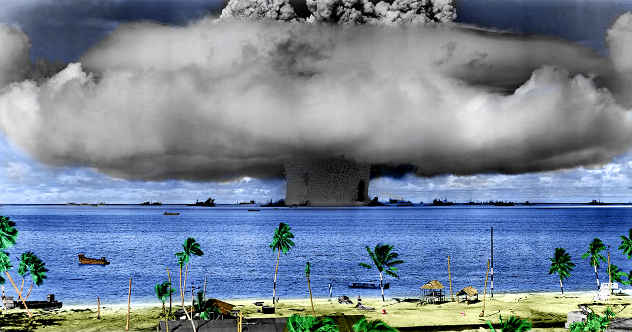
In 1946, a member of the United States Navy approached the people of Bikini Atoll. He told them that they were like the Israelites, a chosen people, and their land was needed to perfect the atomic bomb to prevent future wars. The Bikini Islanders agreed to leave the island temporarily.
The United States government spent the next eight years detonating bombs on the Marshall Islands. They dropped 67 bombs; 23 were dropped on Bikini alone,[2] including one that was a thousand times more powerful than the bomb that destroyed Hiroshima.
In the late 1960s, United States officials announced that most of the effects of its nuclear detonations had worn off. Many of the Bikini Islanders chose to return. Ten years passed, and they began to notice side effects from the radiation. Women had many miscarriages and stillbirths; surviving children often had birth defects. Many Bikini Islanders had developed thyroid problems, and they had a higher rate of cancer than other countries.
Scientists found high levels of radiation, and the people of Bikini Atoll had to leave their home again. The island is still uninhabitable; radiation levels are almost double what is deemed safe for human habitation.
8Geamana, Romania
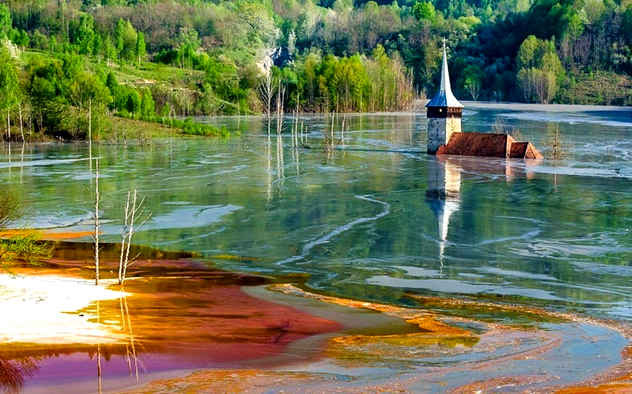
In 1977, Nicolae Ceausescu, dictator of Romania, decided to mine a huge copper deposit. The mine’s toxic waste needed to go somewhere, and Ceausescu decided to sacrifice the town of Geamana. Four hundred families were evacuated and moved elsewhere. Much of the village was replaced by an artificial lake, which would catch the mine’s contaminated sludge.[3]
The copper pit produced around 11,000 tons of copper a year in its prime. The lake grew as the mining increased. All that remains of the town are a church and a few houses. The lake is still rising. It grows one vertical meter each year. Soon the entire town will be covered in toxic sludge.
The lake is poisonous. It contains a variety of chemicals, which have turned parts of the lake red. The lake has ten times the normal amount of cadmium, an extremely toxic metal. Excessive cadmium can cause mutations in plants and animals, and it can damage people’s liver, kidneys, and lungs.
7New Idria, California
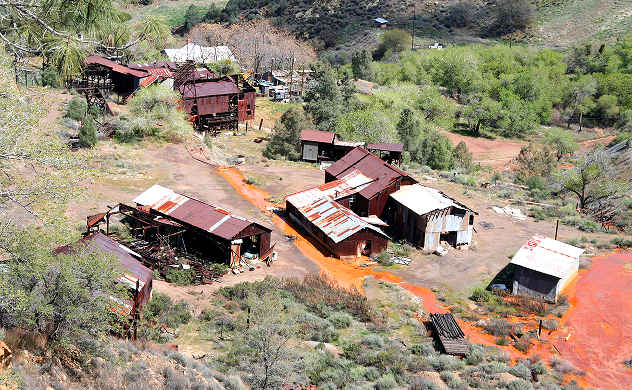
New Idria was founded in 1854 near the largest and one of the most productive mercury mines in the country. The mine was so valuable that armed soldiers were sent to guard it during World War I. Mining continued until 1971 when the company that owned the mine closed. The town was soon abandoned.
No one bothered to clean up the mine. There are at least 30 miles of underground tunnels that leak water loaded with mercury. The water contaminates the local river, which has turned bright orange. The water is tainted with mercury, aluminum, iron, and nickel, and it is nearly as corrosive as battery acid.
The polluted water flows into nearby streams and infects the local wildlife. Bacteria turns mercury into methylmercury, one of the nation’s most serious hazardous waste problems.[4] Methylmercury contaminates fish. People who eat the poisoned fish can experience headaches, tingling, and tremors; some people, especially children, may develop brain and nervous system damage.
6Wittenoom, Western Australia
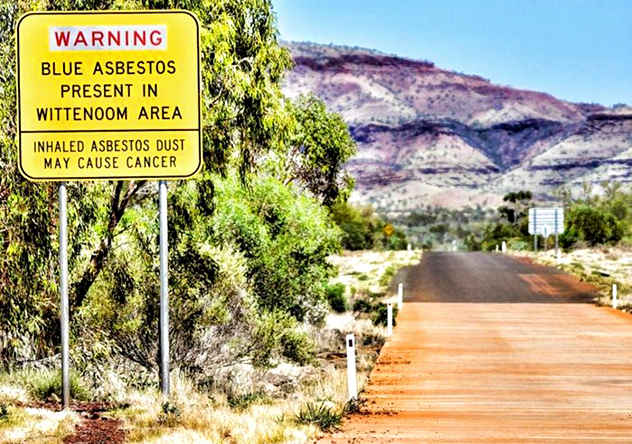
Wittenoom was the largest town located on Australia’s only blue asbestos mine. Mining began in the 1940s and continued for more than 30 years. After the connection between asbestos dust and lung disease became better understood, the Australian government shut down the mine.
The asbestos had already damaged the town and its people. Of the 20,000 people who lived and worked in Wittenoom during the mining period, at least 2,000 have died from asbestos-related diseases.[5] Even people who did not work in the mines were contaminated. Children who grew up in Wittenoom are 20–83 percent more likely to die from cancer than the rest of the population.
The government considered cleaning up Wittenoom, but they decided that it was cheaper and safer to relocate the people and abandon the town. Three million tons of tailings—fine, toxic materials left over after the asbestos was processed—form mounds throughout Wittenoom.
The mounds are not the only source of asbestos that remains. Asbestos tailings were used for decades by the local government as construction material. Roads, pipelines, the airstrip, and golf courses were all filled with asbestos tailings. People brought the tailings into their homes. They were used as sandpits and to reduce dust around the house.
The entire landscape is littered with microscopic asbestos fibers. If inhaled, these fibers can pierce a lung, causing inflammation and releasing mutagens that promote tumor growth. Even a brief exposure to asbestos can cause mesothelioma and lung cancer.
5Pripyat, Ukraine
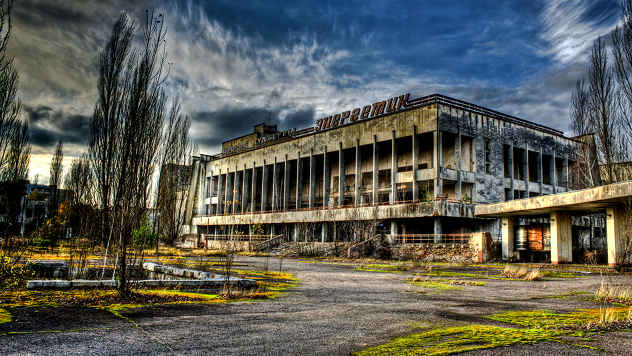
Pripyat was founded two miles away from the Chernobyl Nuclear Power Plant. It was a model city that was designed by some of the best architects; Pripyat was intended to represent a utopian vision of what communism could be: work and social life perfectly balanced and intertwined.
In 1986, a failed safety test caused parts of Chernobyl to explode. Thousands of tons of radioactive waste were sent into the air. The cloud of radiation was so toxic that nearby woodlands simply died.
The Soviet government waited 36 hours to evacuate Pripyat. Many of the residents were already showing signs of radiation poisoning. Thirty-one people died within a month of the Chernobyl accident. At least 9,000 people will die from the effects of the radiation according to the World Health Organization’s cancer research.[6] Greenpeace predicts the long-term death toll could be as high as 90,000.
Pripyat is less radioactive today. Much of the city is less radioactive than going through an airport security scanner three times. A short visit is unlikely to harm someone, although, it would be dangerous to live near the city. Studies of the local wildlife have shown radiation poisoning in both plants and animals. Birds have significantly smaller brains, trees grow slower, and there are fewer insects.
4Treece, Kansas
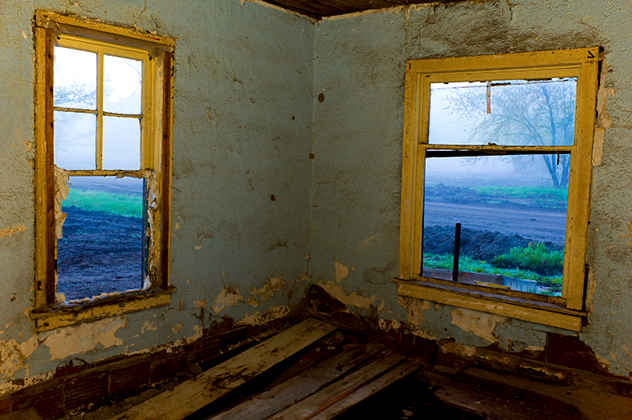
Treece, Kansas sprung up in the early twentieth century after lead, zinc, and iron ore deposits were discovered. Along with Picher, Treece helped supply much of the ore used during the World Wars. The mining stopped during the 1970s, but the town’s environment had long been destroyed.
Treece’s air is deadly. The town is surrounded by millions of tons of lead and zinc mining waste. Mountains of chat flank the city, and the wind blows the dust throughout the town.
Even the ground is dangerous. Years of mining left the earth unstable, and hundreds of cave-ins have occurred.[7] The oldest sinkholes are filled with contaminated water. Children once used them as swimming holes. They would go home with reddened skin, and their parents assumed the children were sunburned. Instead, they had received chemical burns.
Treece residents began to suspect the lead was poisoning them, and blood tests proved them right. The town was declared to be unfit for human habitation. The government sponsored buyouts for people in the town, and nearly everyone accepted. Treece is still being decontaminated, but no buildings will ever be allowed to be built there again.
3Bento Rodrigues, Brazil
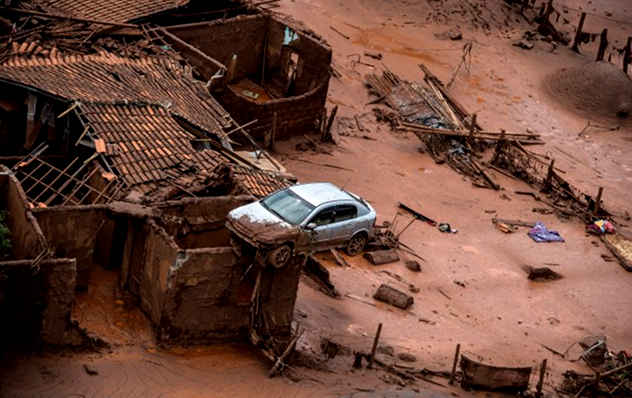
Bento Rodrigues was located near an iron ore mine. The mine’s waste was dumped into a nearby lake, and a dam protected the village from the poisonous water. In 2015, a containment wall at the dam collapsed. Thirty-five million liters (9.2 million gallons) of toxic clay was unleashed.
A 32-foot-tall (10 m) wave of mud crushed Bento Rodrigues. The entire town turned red. Two United Nations environmental experts inspected the mud. They found that it contained high levels of toxic heavy metals and other poisonous chemicals.[8] The experts discovered that the mud had also contaminated the town’s water, which contained arsenic and lead levels that were 10 to 20 times above Brazil’s legal limit.
The mine’s owners had to relocate the people that lived in Bento Rodrigues. The town’s residents may never be able to return home. It will take at least 10 to 50 years for the area’s environment to recover. Although, there is a possibility that the community may never be habitable again.
2Kantubek, Uzbekistan

Kantubek, a small town located on Vozrozhdeniye Island, was once used by the Soviet Union as a bioweapons testing range. Soviet scientists worked on weaponizing diseases, and they tested their weapons on the island. Scientists brought their test subjects—various types of animals—fifteen miles away from the town. The animals were then exposed to different diseases before they were brought back to the lab for testing.
Scientists did their best to stop the diseases from spreading. They sprayed the test area with poison before the diseases were unleashed. However, many rodents burrow, and some probably survived. It is likely that some of these surviving rodents were exposed to weapons-grade bubonic plague bacteria. Fleas would have transmitted the plague from generation to generation. The strain was designed to be resistant to antibiotics, and it would be deadly to humans.
The bubonic plague is not the only dangerous substance on the former island.[9] Vozrozhdeniye once housed a stockpile of anthrax. The United States destroyed tons of anthrax spores that were buried on the island. However, their hasty cleanup may have left a few spores. Anthrax can survive for years buried in the soil.
1Centralia, Pennsylvania

In 1962, officials decided to burn a huge pile of trash at Centralia’s dump. Unfortunately, the town’s dump—and much of the town—was located on top of an abandoned coal mine. After the fire had consumed the trash, it ignited the leftover coal.
The fire began to spread throughout the mines. Carbon monoxide started to seep up from the ground, and people began losing consciousness in their homes. Sinkholes and cracks appeared throughout the town. After a 12-year-old boy fell into a burning sinkhole in the 1980s—he survived—authorities intensified their efforts to douse the fire. Nothing worked. The government realized that they could not stop the fire, and they relocated the residents.
Today, the town is nearly abandoned, and the fire still burns. The fire has consumed much of the mines: it destroyed all of the mine’s timbers and bracing.[10] Parts of the mine could collapse at any moment, which makes the ground above dangerous to walk on. Even Centralia’s air is deadly. Sulfurous steam blows out of hundreds of fissures and holes in the mud. The gases poison the air, and they can suffocate a person.
Read more about interesting abandoned places on 10 Places Frozen In Time and 10 Creepy Abandoned Places.
